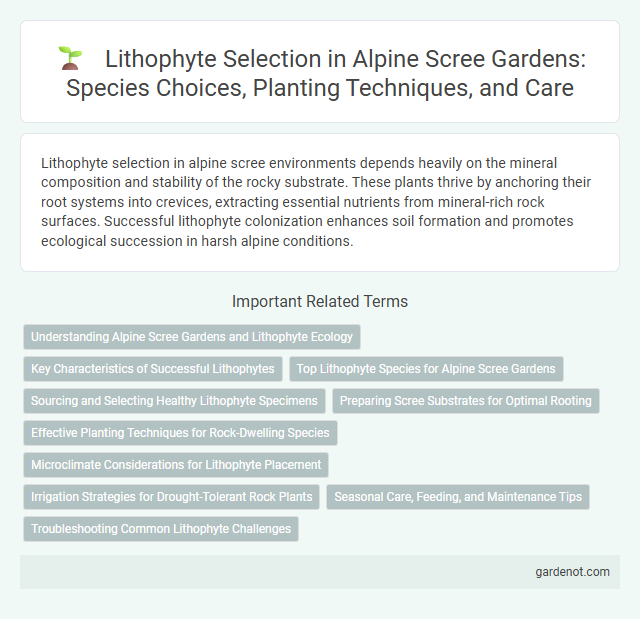Lithophyte selection in alpine scree environments depends heavily on the mineral composition and stability of the rocky substrate. These plants thrive by anchoring their root systems into crevices, extracting essential nutrients from mineral-rich rock surfaces. Successful lithophyte colonization enhances soil formation and promotes ecological succession in harsh alpine conditions.
Understanding Alpine Scree Gardens and Lithophyte Ecology
Alpine scree gardens mimic the natural rocky habitats where lithophytes thrive, characterized by well-drained, mineral-rich substrates with minimal organic matter. Selecting suitable lithophytes requires understanding their adaptations to extreme conditions such as temperature fluctuations, intense UV radiation, and limited water retention in scree environments. Emphasizing species like Saxifraga and Sedum ensures ecological compatibility and promotes sustainable growth within alpine scree ecosystems.
Key Characteristics of Successful Lithophytes
Successful lithophytes in alpine scree exhibit specialized root systems adapted for minimal soil retention, enabling efficient anchorage on rocky substrates. These plants demonstrate high tolerance to desiccation, temperature fluctuations, and nutrient-poor environments through physiological adaptations such as CAM photosynthesis and thickened leaf cuticles. Their ability to extract moisture and nutrients from rock crevices and atmospheric sources ensures survival in harsh, unstable scree habitats.
Top Lithophyte Species for Alpine Scree Gardens
Saxifraga oppositifolia, Androsace alpina, and Draba aizoides are top lithophyte species ideally suited for alpine scree gardens due to their exceptional drought tolerance and ability to thrive in rocky, nutrient-poor substrates. These species exhibit specialized root structures that facilitate anchorage and efficient nutrient absorption in crevices and loose scree environments. Cultivating these lithophytes enhances biodiversity while ensuring sustainable plant growth in challenging alpine scree habitats.
Sourcing and Selecting Healthy Lithophyte Specimens
Sourcing healthy lithophyte specimens for alpine scree environments requires careful assessment of plant vigor, root integrity, and absence of disease or pests, ensuring optimal establishment and growth. Selecting specimens from native or ecologically similar habitats promotes adaptability and resilience to alpine conditions, enhancing long-term survival. Emphasis on robust root systems and minimal substrate disturbance during collection supports successful transplantation and sustainable scree garden development.
Preparing Scree Substrates for Optimal Rooting
Preparing scree substrates for optimal rooting involves selecting lithophytes well-adapted to harsh alpine conditions, emphasizing plants capable of thriving in mineral-rich, well-drained environments. Ensuring substrate composition with a balanced mixture of coarse gravel, sand, and organic matter mimics natural alpine scree, enhancing root aeration and moisture retention critical for lithophyte establishment. Regular monitoring of pH levels and nutrient availability supports healthy root development, promoting successful acclimatization and growth within scree habitats.
Effective Planting Techniques for Rock-Dwelling Species
Effective planting techniques for alpine scree lithophytes involve selecting species adapted to high-altitude, nutrient-poor, well-drained rocky substrates, such as Saxifraga and Sedum varieties. Ensuring proper root anchorage by inserting plants into crevices filled with minimal organic matter mimics natural conditions and enhances water retention. Utilizing slow-release fertilizers tailored for alpine plants supports growth without overwhelming the delicate rock-dwelling ecosystem.
Microclimate Considerations for Lithophyte Placement
Optimal lithophyte placement in alpine scree habitats relies on microclimate factors such as sunlight exposure, wind protection, and moisture retention. Selecting sites with stable thermal conditions and adequate humidity supports lithophyte growth despite extreme temperature fluctuations and desiccation risks. Microtopography variations influence microclimatic niches, enhancing lithophyte survival by providing shelter and regulating soil moisture levels.
Irrigation Strategies for Drought-Tolerant Rock Plants
Effective irrigation strategies for alpine scree lithophytes prioritize minimal water usage while ensuring root zone moisture retention through drip irrigation or misting systems. Selecting drought-tolerant rock plants such as Saxifraga, Sedum, and Sempervivum species enhances survival under fluctuating moisture conditions. Employing soil amendments like grit or coarse sand improves drainage, preventing root rot and optimizing water uptake efficiency.
Seasonal Care, Feeding, and Maintenance Tips
Alpine scree lithophytes require well-draining substrate and minimal watering during dormancy to prevent root rot and promote healthy growth. Fertilize with a diluted, balanced liquid fertilizer monthly during the active growing season, typically spring through early autumn, to enhance nutrient uptake. Regularly remove debris and monitor for pests to maintain plant vigor and prevent fungal infections in high-altitude, rocky environments.
Troubleshooting Common Lithophyte Challenges
Addressing common lithophyte challenges in alpine scree involves optimizing substrate composition to enhance root adhesion and moisture retention. Monitoring microclimatic factors such as wind exposure and temperature fluctuations is critical to prevent desiccation and nutrient deficiencies. Implementing tiered irrigation systems and using mycorrhizal inoculants can significantly improve lithophyte establishment and growth stability.
Lithophyte selection Infographic

 gardenot.com
gardenot.com